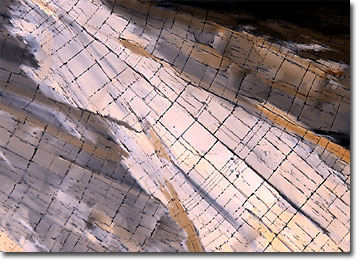Polarized Light Microscopy Digital Image Gallery
Parathion
Parathion is an organophosphate insecticide that can only be legally applied to certain crops in the United States, such as alfalfa, barley, and soybeans, and can only be purchased by licensed applicators. The reason for such governmental regulations is the high toxicity of parathion to humans and other animals.

Similar to other organophosphate insecticides, parathion acts by inhibiting cholinesterase, an enzyme essential for the proper functioning of the nervous system. Through this action, the substance is able to effectively kill a wide range of insects and mites. Unfortunately, however, parathion may also affect the human nervous system and is highly toxic no matter how it enters the body. Indeed, there have been documented fatalities of individuals exposed via ingestion, absorption through the skin, and inhalation. When acute poisoning occurs to a lesser extent, a number of symptoms may occur, including nausea, vomiting, pallor, stomach cramps, sweating, tearing of the eyes, vertigo, and confusion. Severe poisoning may be accompanied by slurred speech, loss of coordination, tremors, weakness, and paralysis.
In its pure form, parathion exhibits a faint garlic-like odor and appears as a pale yellow liquid. When prepared for technical use, however, the substance typically is darker in color, ranging from a deep brown to a golden yellow. For commercial use, parathion is available in several different forms, such as dust, granules, wettable powders, and emulsion concentrate. Though generally stable at normal temperatures, the insecticide slowly hydrolyzes at pH levels of 7 or below and decomposes at temperatures that exceed 120 degrees Celsius. In cases of thermal decomposition, a number of toxic gases may be released by the organophosphate.
